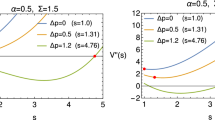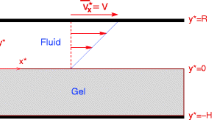Abstract
We show that a viscoelastic solid, modelled by a three-dimensional analogue of the Kelvin-Meyer-Voigt equation (the neo-Hookean rubber-like body and the Oldroyd-B element in parallel), has an exact similarity solution in the torsional flow geometry, including inertia. Numerical results obtained by a finite difference method for the oscillatory torsional flow indicate that the flow loses its stability at high amplitudes of oscillations. This is partly explained by a linear stability analysis of a simpler flow generated by a constant angular displacement.
Similar content being viewed by others
Author information
Authors and Affiliations
Additional information
Received 10 December 2001 / Accepted 12 March 2002
Rights and permissions
About this article
Cite this article
Phan-Thien, N. Oscillatory torsional flow of a viscoelastic solid. Computational Mechanics 29, 143–150 (2002). https://doi.org/10.1007/s00466-002-0325-z
Issue Date:
DOI: https://doi.org/10.1007/s00466-002-0325-z




